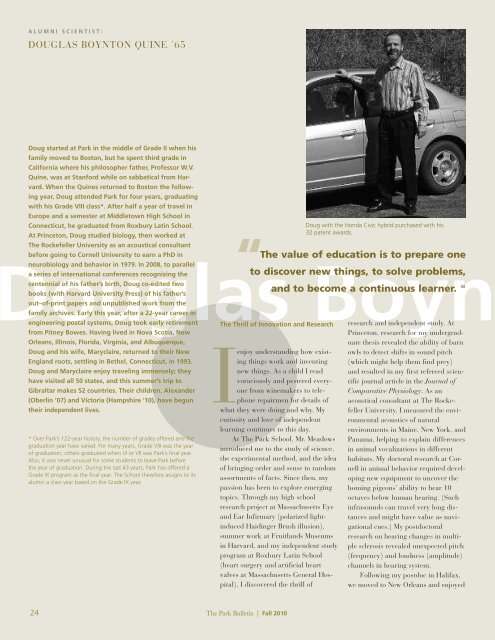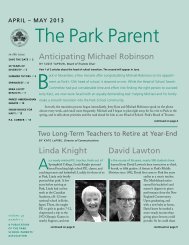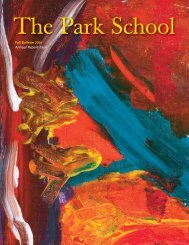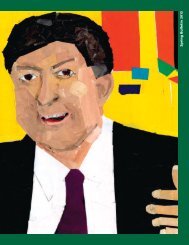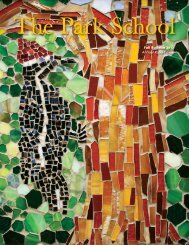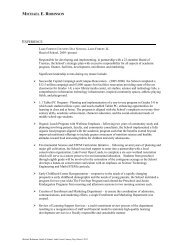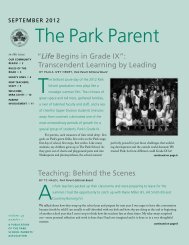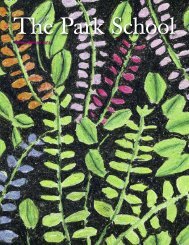⢠ParkBulletinCover - The Park School
⢠ParkBulletinCover - The Park School
⢠ParkBulletinCover - The Park School
- No tags were found...
Create successful ePaper yourself
Turn your PDF publications into a flip-book with our unique Google optimized e-Paper software.
A L U M N I S C I E N T I S T :DOUGLAS BOYNTON QUINE ’65Doug started at <strong>Park</strong> in the middle of Grade II when hisfamily moved to Boston, but he spent third grade inCalifornia where his philosopher father, Professor W.V.Quine, was at Stanford while on sabbatical from Harvard.When the Quines returned to Boston the followingyear, Doug attended <strong>Park</strong> for four years, graduatingwith his Grade VIII class*. After half a year of travel inEurope and a semester at Middletown High <strong>School</strong> inConnecticut, he graduated from Roxbury Latin <strong>School</strong>.At Princeton, Doug studied biology, then worked at<strong>The</strong> Rockefeller University as an acoustical consultantouglas BoynIbefore going to Cornell University to earn a PhD inneurobiology and behavior in 1979. In 2008, to parallela series of international conferences recognizing thecentennial of his father’s birth, Doug co-edited twobooks (with Harvard University Press) of his father’sout–of-print papers and unpublished work from thefamily archives. Early this year, after a 22-year career inengineering postal systems, Doug took early retirementfrom Pitney Bowes. Having lived in Nova Scotia, NewOrleans, Illinois, Florida, Virginia, and Albuquerque,Doug and his wife, Maryclaire, returned to their NewEngland roots, settling in Bethel, Connecticut, in 1993.Doug and Maryclaire enjoy traveling immensely; theyhave visited all 50 states, and this summer’s trip toGibraltar makes 52 countries. <strong>The</strong>ir children, Alexander(Oberlin ’07) and Victoria (Hampshire ’10), have beguntheir independent lives.* Over <strong>Park</strong>’s 122-year history, the number of grades offered and thegraduation year have varied. For many years, Grade VIII was the yearof graduation; others graduated when VI or VII was <strong>Park</strong>’s final year.Also, it was never unusual for some students to leave <strong>Park</strong> beforethe year of graduation. During the last 43 years, <strong>Park</strong> has offered aGrade IX program as the final year. <strong>The</strong> <strong>School</strong> therefore assigns to itsalumni a class year based on the Grade IX year.<strong>The</strong> Thrill of Innovation and Researchenjoy understanding how existingthings work and inventingnew things. As a child I readvoraciously and pestered everyonefrom winemakers to telephonerepairmen for details ofwhat they were doing and why. Mycuriosity and love of independentlearning continues to this day.At <strong>The</strong> <strong>Park</strong> <strong>School</strong>, Mr. Meadowsintroduced me to the study of science,the experimental method, and the ideaof bringing order and sense to randomassortments of facts. Since then, mypassion has been to explore emergingtopics. Through my high schoolresearch project at Massachusetts Eyeand Ear Infirmary (polarized lightinducedHaidinger Brush illusion),summer work at Fruitlands Museumsin Harvard, and my independent studyprogram at Roxbury Latin <strong>School</strong>(heart surgery and artificial heartvalves at Massachusetts General Hospital),I discovered the thrill ofDoug with the Honda Civic hybrid purchased with his32 patent awards.<strong>The</strong> value of education is to prepare oneto discover new things, to solve problems,and to become a continuous learner.research and independent study. AtPrinceton, research for my undergraduatethesis revealed the ability of barnowls to detect shifts in sound pitch(which might help them find prey)and resulted in my first refereed scientificjournal article in the Journal ofComparative Physiology. As anacoustical consultant at <strong>The</strong> RockefellerUniversity, I measured the environmentalacoustics of naturalenvironments in Maine, New York, andPanama, helping to explain differencesin animal vocalizations in differenthabitats. My doctoral research at Cornellin animal behavior required developingnew equipment to uncover thehoming pigeons’ ability to hear 10octaves below human hearing. (Suchinfrasounds can travel very long distancesand might have value as navigationalcues.) My postdoctoralresearch on hearing changes in multiplesclerosis revealed unexpected pitch(frequency) and loudness (amplitude)channels in hearing system.Following my postdoc in Halifax,we moved to New Orleans and enjoyed24 <strong>The</strong> <strong>Park</strong> Bulletin | Fall 2010


